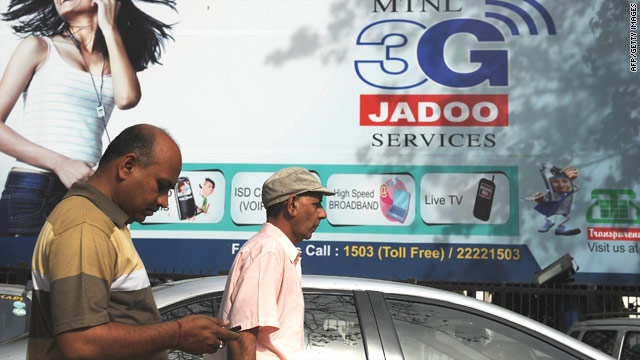 New Delhi, India (CNN) -- In the good old days, Indians would wait for years for a telephone line to be installed in their homes and workplaces.
New Delhi, India (CNN) -- In the good old days, Indians would wait for years for a telephone line to be installed in their homes and workplaces.Until the early 1990s, a phone was seen as a luxury.
But today, India's vast underclass is almost as well connected as the rich in what is hailed as a telecom revolution that has delivered mobile telephony to nearly 600 million people in just a little over a decade.
The nation is now preparing for another giant leap into the digital world as it auctions off its airwaves for third-generation (3G) services to enable super-fast multimedia streaming on wireless networks.
Industry leaders Vodafone Essar, Bharti Airtel, Reliance Telecom and six other companies began bidding last week for slots in 22 zones -- called circles -- of India's telecom market.
The auction, with a reserve price of $787 million, is being held online on a secure Web site, according to officials.
The process is expected to run for days or weeks. The government has not set a closing date for the auction.
The government wants to award the 3G frequency space later this year, said Satyendra Prakash, a spokesman for the communications ministry.
Also, there will be a follow-up auction of broadband wireless access that has attracted 11 bidders, telecommunications officials say.
Analysts forecast that 3G systems will boost India's internet penetration with technology allowing quick access, data transfer and entertainment on mobile handsets.
India's online market has not kept pace with the country's booming mobile-phone business despite the country's image as an IT powerhouse.
Raj Pal, an adviser at the Telecom Regulatory Authority of India, says the nation had barely 15.24 million internet users in December last year. Among them were 7.82 million broadband subscribers, he added.
Independent surveys suggest about 71 million Indians claimed to have logged on in 2009, still a tiny fraction of the country's population of 1.2 billion.
Analysts now foresee another revolution ahead as the current second-generation (2G) mobile services are replaced by a successor.
"3G is going to do to the Internet in India what 2G did to mobile telephony," said Kunal Bajaj, India director of British-based consultancy firm Analysys Mason.
More than 130 countries already are using the third-generation platform, he said.
India has announced a program aimed at linking up all its 250,000 village councils by 2012 in a bid to plug massive broadband divides between rural and urban communities as the country emerges as one of the world's few growth markets.
Indians often complain of poor connectivity and abrupt termination of mobile calls. Bajaj explains that is because of signal congestion on cell-phone towers.
Experts believe 3G technology, for now, will be used to improve existing services on strained networks.
"The initial focus is expected to be on improving quality of calls," says Bajaj. "It will shift to multimedia application over a period of time," he adds.

No comments:
Post a Comment